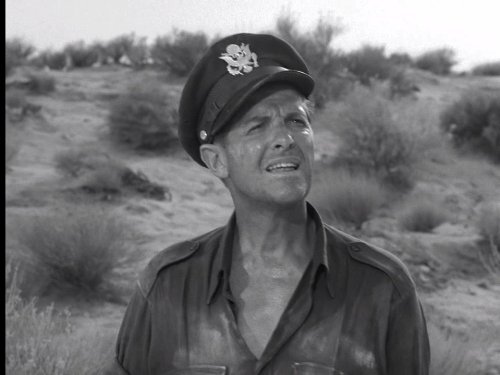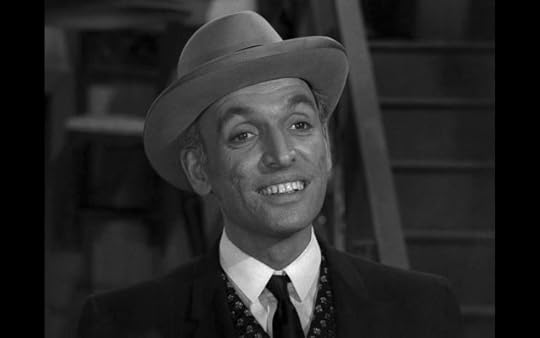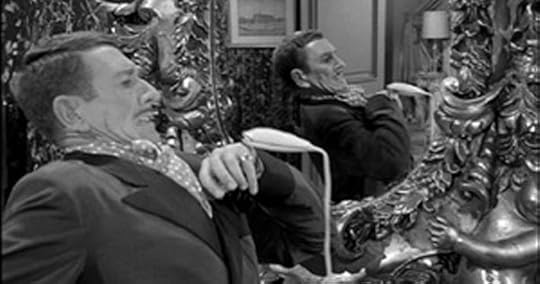August 3, 2024: The Twilight Zone rewatch continues with season 2 episodes 1-4!
Season 2, Episode 1 “King Nine Will Not Return“
This episode was first telecast September 30, 1960.
This was the first episode to feature the classic Marius Constant theme.
Rod Serling appears onscreen to introduce the episode, a new wrinkle in the show format. According to Martin Grams Jr. in The Twilight Zone: Unlocking the Door to A Television Classic: “Serling was nervous when standing in front of the camera, tensing up when filming for the episodes commenced. While he looked tall on the screen, his height was five foot five and with nothing on camera of a specific height to purposely compare him with, much of the television audience was unaware of this fact. “I really don’t like to do hosting. I do it by default. I have to,”Serling explained to a reporter from the United Press International in August of 1963. “If I had my druthers, I wouldn’t do it. If I had to go on live, of course, I’d never do it.”
This episode was based on the true story of the American B-24 bomber Lady Be Good that disappeared in 1943 and was discovered 16 years later in the LIbyan desert. The crash site was well-preserved but the bodies of the plane’s crew were missing. The remains of eight of the nine crew members were eventually recovered the following year. The incident also inspired the 1970 MOW Sole Survivor that focused on the ghosts of the fallen crew. The 1964 novel Flight of the Phoenix avoided supernatural elements in favor of focusing on the quest for survival.
A military surplus B-25 was purchased for the shoot at a cost of $25000. The plane was disassembled and reassembled on site.
Portions of this episode were shot at Edwards Air Base in California on a 110 degree day.
Robert Parrish was initially scheduled to direct this episode but, for some reason, Buzz Kulnik ended up behind the camera. Kulnik would go on to direct another eight episodes of the show while Parrish would not return. Kulnik’s directorial crown jewel would be 1971’s Brian’s Song.
Actor and comedian Robert Cummings, who played Captain James Embry, enjoyed a successful acting career, first in film and later in television where he headlined The Bob Cummings Show (1955) and My Living Doll (1964). He was the star of the original Studio One live 1954 production of Twelve Angry Men, a role later made famous by Henry Fonda in the 1957 film version. Cummings was a USAF flight instructor and health food fantastic who purportedly carried a suitcase full of vitamins with him wherever he went. His final role was a 1977 episode of The Love Boat after which he retired from acting.
Actor Gene Lyons, who played the psychiatrist in this episode, is perhaps better known for his portrayal of Ambassador Fox in the Star Trek’s “A Taste of Armageddon” (1967).
I’m quite surprised they elected to kick off the show’s second season with this episode. It’s almost 20 full minutes of our protagonist aimlessly wandering about, hallucinating, questioning his sanity – all buttressed by a lengthy (but admittedly necessary) inner monologue. When we finally cut back to the hospital, I considered this episode as an inferior version of the show’s pilot episode, “Where Is Everybody?”, and then with the nonsensical twist at episode’s end – the sand in the shoe – I honestly didn’t know quite know what to make of it. Overall, a massive disappintment for me.
Season 2, Episode 2 “The Man in the Bottle”
This episode was first telecast October 7, 1960.
Rod Serling had an alternate ending planned in which the bottle is picked up by a homeless man who walks off with it, presumably to experience his own wish-filled adventure. It’s unclear why it was changed.
Luther Adler, who played shop owner Arthur Castle, was the only Jewish actor to have played Hitler three times.
Vivi Janiss, who played Arthr’s wife Edna, was once married to actor Robert Cummings who appeared as the downed bomber pilot in the previous episode.
Joseph Ruskin, who played the diabolical genie, played Galt in Star Trek’s: “The Gamesters of Triskelion” (1968). He was one of only five actors to appear in both Star Trek (1966) and Star Trek: Enterprise (2001).
Olan Soule, who played the IRS agent, was a busy character actor and the first to voice Batman in an animated feature. He also appeared in both the radio and t.v versions of Captain Midnight, in the former as Agent Kelly, SS-11; in the latter as the scientist Tut.
Two episodes in and we’re back with another “Be happy with what you have” episode – in this case “what you have” being a mountain of debt and impending backruptcy. A riff on The Monkey’s Paw, this episode is a complete misfire although I did find it pretty funny when the IRS agent calculated the taxes owing on the million dollars at roughly 900k. A 90% tax rate! What is this? France?! And the moment when our protagonist realizes he is Hitler is so ridiculous, his performance so over-the-top, that it bordered on parody. I thought Ruskin as the genie was suitably creepy, but found his nefarious laughter – which seems to have been dubbed in after the fact – also pretty OTT. Two episodes into the show’s second season and I feel like I’ve already got two candidates for my Top 10 Worst Episodes of Season 2.
Season 2, Episode 3 “Nervous Man in a Four Dollar Room“
This episode originally aired October 14, 1960.
The script called for Serling to step in front of a freeze frame of actor Joe Mantell to deliver his opening intro, but director Douglas Heyes elected to film the introduction from the ceiling in such a way that allowed Serling to step out in front of a rear projection and effectively walk on the wall.
In discussing his approach to having the character of Jackie Rhoades interact with his alternate self, Heyes explained: “…instead of doing it with a split screen or over another actor’s shoulder the easy way, I wanted to do it the hard way – with rear projection. First, we photographed every part of Joe Mantell’s performance that was in the mirror, and then later he played against [his own perfromance projected onto the mirror during the take]. So when we were photgraphing the mirror stuff, we also had another actor playing out front who was maing Joe’s moves, so that Joe in the mirror was actually looking in the direction where Joe the actor would be later, when I photographed it for the second time.”
Apparently, the production received two pitches for stories with somewhat similar plots about an individual fighting an inner battle with an alternate version of himself who appears in a mirror. TWO PITCHES! But at the time prep was well underway on the episode and Serling decided to forge ahead. P.S. This is why writers won’t read other people’s ideas! A similar plot is used in season 5’s “The Last Night of a Jockey” starring Mickey Rooney. In the 1980’s Twilight Zone Revival, Bruce Willis plays the lead in a similar story, “Shatterday”.
The Jackie Rhoades characters utters the line “You talkin’ to me?” at his reflection 16 years before DeNiro’s Travis Bickle in Taxi Driver (1976).
The name George is said 56 times in this episode, 20 times in the opening two minutes.
Actor Joe Mantell, who played Jackie Rhoades in this episode, was a prolific character actor on Broadway, and later film and television. He received an Oscar nomination for the role of Angie, best friend to Ernest Borgnine’s Marty in the movie Marty (1955). Mantell also has the distinction of uttering one of cinema’s most memorable final lines in 1974’s Chinatown: “Forget it Jake, it’s Chinatown.”
Honestly, not a bad episode. Better than the season 2 opener, and certainly a huge improvement over the preceding entry. Mantell does a great job here as the desperate Jackie, delivering a credibly frenzied performance despite, at times, some pretty hammy dialogue. Although the ending holds the promise of a bright new future for Jackie, I can help but think that, in the real world, George would get his payback much sooner thanlater. Finally, Kudos to director Douglas Heyes for the inspired composition of that Serling intro.
Season 2, Episode 4 “A Thing About Machines”
This episode was first broadcast October 28, 1960.
Rod Serling on the inspiration for this episode: “This one I got trying to shave with a razor during a given morning when those appliances in my house gave out. A washer, a dryer, and a television set. It occurred to me how absolutely vulnerable we are to gadgets, gimmicks and electronic jim-crackery.”
In the original draft, Finchley is pursued into his garage and backed up against a wall as the car bears down on him. The next morning he is found, slumped against the wall, presumably dead of a heart attack.
Many fans found the alternate ending confusing and the production received many letters from viewers wondering why Finchley’s body did not float and is found at the bottom of the pool.
Looking back, Serling was not a fan of the episode. Said Serling in one interview: “Mr. Finchley drowned in his swimming pool. Upon reflecting, I wish I had before I wrote the bloody thing.”
Stephen King has stated that part of the inspiration for his book, Christine (1983), came from this episode’s final sequence.
Actor Richard Haydn, who played Bartlett Finchley in the episode, started his show biz career as a ticket seller and unsuccessful comedian. He became the overseer of a Jamaican banana plantation but, when it was wiped out by a hurricane, he returned to acting, finding early success on radio. He parlayed that success into a solid career playing comical roles in features and voicing cartoon characters. Onscreen, he is perhaps best known as Max Detweiler, the von Trapp family’s friend and promoter in The Sound of Music (1965) Haydn was a recluse and avid horticulturist – so much so that his friend and neighbor, David Niven, once said Haydn only took roles so he could pay for his garden.
Actress Barbara Stuart, who played Finchley’s secretary Ms. Rogers, was a casting agent who would occasionally cast herself. She is perhaps best known as Sgt. Carter’s girlfriend, Bunny, in Gomer Pyle: USMC (1964).
Actor Barney Phillips, who plays the t.v. repairman, makes his second (of four) Twilight Zone appearances here.
This was a middling episode. Better than the first two. Not as good as the last one. While I enjoyed Richard Haydn’s scenery-chewing performance, I did wonder (as I often do while watching the “funnier” episodes) if this story might have been better served with a darker tone. Then again, I can’t imagine a genuinely nefarious version of that killer electric shaver coming down the stairs.
So, what did you all think?
The post August 3, 2024: The Twilight Zone rewatch continues with season 2 episodes 1-4! appeared first on Joseph Mallozzi's Weblog.
Joseph Mallozzi's Blog
- Joseph Mallozzi's profile
- 39 followers







